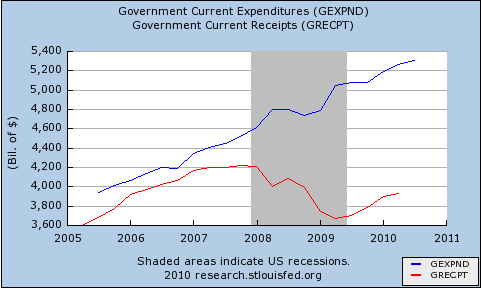Boy, this morning’s Wall Street Journal page one leaves a lot to be desired.
First, there’s this story:
States Offer Washington Lesson in Belt Tightening
The headline implies—and the entire story accepts as gospel—the conventional wisdom that Washington needs to get busy and slash the deficit. There’s nothing—not one thing—in this page-one story acknowledging that it might be a bad idea to cut spending when the economy’s in the shitter and one in six are un- or underemployed. Why not? Remember 1937?
Here’s the lede, which all but advocates the deficit-hawk position:
The U.S. government is now borrowing $5 billion every business day and has done nothing more than talk about a plan to reduce its debt. State governments don’t have that luxury.
The Journal says zippo about the fact that the deficit is largely due to the depressed economy. This is not a difficult concept. Here’s a chart from Paul Krugman (the effective leader of the anti-Austerity Now caucus) that vividly illustrates it:
Get the economy growing again. Tax receipts will soar (even without tax increases) as incomes rise and expenditures will fall (even without spending cuts) as people bounce out of the safety net. You’ll still have a deficit of 3 percent to 5 percent of GDP due primarily to Bush-era tax cuts and spending programs, but that number is long-term manageable even if you do nothing about those. (UPDATE: For more on that see David Leonhardt’s excellent column in The New York Times today)
There are long-term structural issues to deal with at some point—mostly health care. But slashing spending now will hurt the economy significantly, according to every liberal economist and many non-liberals. You wouldn’t know that from this one-sided story.
— This ahed sucks. It’s not even an ahed, it’s just a very non-special story slotted in the place where the ahed normally rests because top editors wanted to put Prince William’s engagement on the front page of The Wall Street Journal. Boo.
This is as close as we get as a rasion d’etre for this story:
As Britain’s Prince William announced his engagement to longtime girlfriend Kate Middleton, the couple stepped into the spotlight with the ease of media-romance veterans. They have already spent an eight-year courtship under the harsh scrutiny that comes with the possibility of one day being the King and Queen consort of the United Kingdom of Great Britain and Northern Ireland—not to mention fifteen other Commonwealth realms.
The couple have been photographed on ski slopes and coming and going from nightclubs in the wee hours. Ms. Middleton was branded “Waity Katie” by British tabloids in honor of her long wait for the prince to pop the question. A brief breakup a few years ago has been combed over like a key episode in Churchill’s war rooms…
By agreeing to take each other in holy matrimony, the couple has volunteered to be the lead players in one of Britain’s signature spectacles: a royal wedding with all the trimmings, chiming church bells and horse-drawn carriages.
Here are the first three commenters I see on the story on WSJ.com:
Pablo Sameole wrote: For a moment I thought I was on the TMZ site.
Helmut Mueller wrote: Big deal. Who cares?
carlos haugabrook replied: I second that, 1,000,000 times!!!!!!!
The New York Times, thankfully, exercised better news judgment: A14.
— Then there’s the above-the-fold, four-column play for a story that’s framed around a PR push by the FDIC (“Hey, we’re not doing nothing!”), and which isn’t news, anyway. It was reported by the L.A. Times seven days ago.
Unlike the two stories above, this one isn’t all bad. There’s good information about what regulators have been up to, juxtaposed nicely with what they were up to during the S&L scandal:
The S&L crisis of the 1980s and 1990s killed more than 1,800 institutions. From 1990 to 1995, federal officials prosecuted about 1,850 bank insiders. More than 1,000 officers, directors and other officials went to prison, and federal agencies collected $4.5 billion in professional-liability claims.
In the current mess, no high-profile banker has been criminally charged in connection with a financial institution’s demise, as Charles Keating was for fraud after American Continental Corp. failed in 1989.
— The fourth story is fine. It’s a good news story about the Irish/Euro crisis, though it doesn’t go much beyond commodity news.
And the dominant art is an arresting photograph of the president awarding a soldier the Medal of Honor.
But all in all, it’s not a good showing.
Ryan Chittum is a former Wall Street Journal reporter, and deputy editor of The Audit, CJR’s business section. If you see notable business journalism, give him a heads-up at rc2538@columbia.edu. Follow him on Twitter at @ryanchittum.

